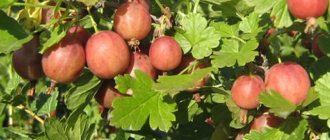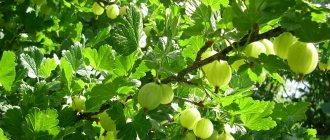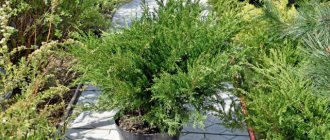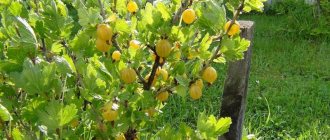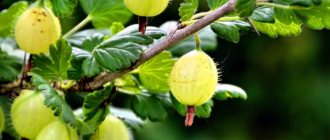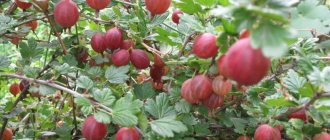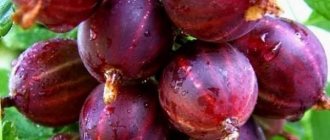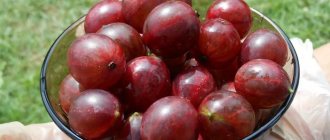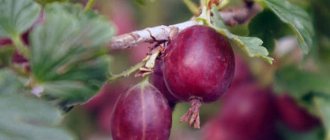Gooseberries are a high-yielding berry crop. The plant has positive reviews and is popular among gardeners. Feels great in regions with a temperate climate. The bush annually produces a good harvest of tasty fruits. The berries are valued not only for their pleasant sweet and sour taste, but also for their beneficial properties. The fruits contain vitamins C, P, A, B, folic acid, and microelements.
Gooseberry Krasnoslavyansky
Important! Gooseberries have a beneficial effect on metabolic processes in the body, remove toxins, normalize blood pressure, cleanse, strengthen blood vessels, and prolong youth.
Breeders have developed a large number of crop varieties. Among them there are many shrubs without thorns. However, summer residents still give preference to gooseberries with thorns. This is no coincidence - the berries have a higher taste, and the bushes are not picky about weather conditions.
Among these varieties, the red gooseberry Krasnoslavyansky stands out. It was developed by domestic scientists. The process of creating culture took place in Leningrad. Parents of Krasnoslavyansky are varieties Oregon, Avenarius. In 1992, Krasnoslavyansky took a place in the State Register of Selection Achievements.
Description of the gooseberry variety Krasnoslavyansky
The bush is medium spreading, leafy. Height 150 cm. Shoot thickness is average. Their color varies from light brown to green. The spininess is strong. The entire length of the branches are covered with large thorns. The stems are not thick, erect. The buds are small and brown.
The leaves of the gooseberry variety Krasnoslavyansky are wide-rounded, green, and medium in size, as can be seen in the photo above. The surface is slightly wrinkled, smooth, matte. There is no pubescence on the upper part of the leaf blade. The flowers are bell-shaped, yellow in color, and medium in size. 1-2 inflorescences are placed on one brush.
The shape of the berries is round or slightly elongated, large in size. The average weight of one fruit is 6 g. There is slight pubescence over the entire surface of the fruit. When ripe, the berries are burgundy in color. The rich taste and aroma of gooseberries is felt. The skin is thin. The pulp is juicy, sweet, tender. One fruit contains up to 45 small seeds.
Description of the bush and berries
The bush of the Krasnoslavyansky gooseberry variety is medium-sized and slightly spreading (as in the photo below). The height of the gooseberry is about 150 cm. The stems are medium thick, erect. Their colors are not the same: the bottom is light brown, the rest of the shoot is green. There are sharp and thick thorns along the entire length of the stem. The Krasnoslavyansky variety has small brown buds with sharp tips.
The emerald green leaf blades are located at an angle to the shoot. The leaves are round, dull or with a slight sheen. The upper part is smooth, the lower part is pubescent. Leaf wrinkling is mild. Gooseberries of the Krasnoslavyansky variety bloom with yellowish flowers in the shape of bells. Brushes with one or two colors.
The berries are large, round or slightly elongated. There is dense pubescence over the entire surface. Berries weighing up to 6 grams. When ripe, the fruits of the Krasnoslavyansky gooseberry variety are red in color with a pronounced gooseberry aroma. The berries of the Krasnoslavyansky gooseberry variety taste sweet with tender and juicy pulp. The skin is thin. Each berry contains about 45 seeds.
Advice! You need to wear gloves when picking berries to avoid pricking your hands with thorns.
Short description:
| Life form | Bush |
| Height | up to 150 cm |
| Crown | slightly spreading |
| Fruit | round or slightly elongated |
| Weight | up to 6 g |
| Taste | sweet and sour, dessert |
| Productivity | about 6 kg |
| Maturation period | average ripening period |
| Shatterability | strong in ripe berries |
| Winter hardiness | high |
Advantages and disadvantages
Each varietal plant has advantages and disadvantages that gardeners pay attention to when choosing a variety. This is what the Krasnoslavyansky gooseberry variety is.
| Advantages | Flaws |
| Excellent taste and visual appeal of berries | Sharp thorns make harvesting difficult |
| High yield | Ripe berries do not stay on the cuttings and quickly fall off |
| Mid-late ripening | Average incidence of fungal diseases |
| Unpretentiousness of gooseberries | |
| Transportation does not affect the presentation of the berries | |
| Ripe berries will keep for a week in the refrigerator. |
Characteristics and features of the variety
Frost resistance
Krasnoslavyansky gooseberry is a frost-resistant crop. It can withstand harsh winters without any problems, when the air temperature drops to -30...-35 degrees. The only condition is that the bush must be under snow cover. Snow reliably protects the plant not only from frost, but also from winds, which gooseberries do not like. If the snow cover is small and the temperature begins to drop sharply, then the crop needs to be covered with a layer of snow.
Productivity
The shrub belongs to varieties with an average ripening period. Along with Krasnoslavyansky, the varieties Mashenka, Consul, Chernoslivovy, and Salyut ripen. The first ripe berries are harvested in early August. The bush bears fruit for about half a month. Fruit ripening is smooth. Collection is easy. The berries are separated from the stalks without much difficulty. During the season, 4-7 kg of berries are collected from the plant. After planting a seedling, the gooseberry begins to bear fruit in the second year, producing its maximum yield after 6-8 years. Until this time, summer residents collect 1.5-3 kg of fruits from the bush.
Important! Krasnoslavyansky gooseberry is considered a long-lasting crop. With constant and proper care, the shrub can bear fruit for 20-30 years.
Bloom
Krasnoslavyanskiy blooms in May or early June. Flowering lasts on average from one to two weeks. After this process, ovaries are formed on the hands. Flowers are self-pollinating. They have one pistil and five stamens. The shape of the flowers resembles bells. Color – pale, light yellow. Size – medium. The number of petals is five.
There are one or two flowers on the racemes. Three-flowered racemes are less common. The number of brushes on each branch is from 10-15 pieces. The harvest should be expected 1.5-2 months after flowering.
Branch of blooming gooseberry
Note! Gooseberry flowers do not like the cold very much. If prolonged frosts occur during the flowering of the crop, this may negatively affect the harvest.
Description of the bush
Krasnoslavyansky gooseberry grows up to 1.3-1.6 m. Growth intensity is average. The shrub is compact and neat. The branches are not spreading, not powerful, of medium length and width. They are straight. They grow upward, in different directions, due to this the bush acquires a spherical shape. The shoots are emerald green and darken closer to the roots: the green color turns into brown.
The leaves are small with thin stems. The shape is round. Color – dark emerald. They are matte, partly there is a touch of gloss. There are faint wrinkles. The leaves are made up of lobes. Slightly pubescent downwards. The edges are blunt-toothed. Located at a slight angle relative to the shoot.
The peculiarity of the variety is the abundance of thick thorns. They cover all branches. Located at an angle. The thorns are sharp. They cling to clothes. Color – dark brown.
Fruit
Krasnoslavyansky gooseberry, the variety description of which contains information about large fruits, actually has berries from 4 to 6 grams. each. Shape – round or oval. Color – burgundy-violet, with light stripes. The skin is velvety, elastic, thin, but durable. Inside the berry there are from 25 to 50 seeds. The amount of dry matter is 13-15%.
The fruits of the Krasnoslavyansky gooseberry
The pulp is juicy, aromatic, pale scarlet. Taste qualities are very high, dessert-like. The taste is delicate, richly sweet, with a pleasant note of sourness.
Red berries contain a lot of vitamins and microelements.
Among the useful substances:
- Vitamins A, B, P;
- Folic acid;
- Ascorbic acid;
- Serotonin;
- Iron;
- Potassium;
- Phosphorus;
- Calcium;
- Zinc;
- Copper;
- Manganese.
Additional Information. Serotonin is called the hormone of joy. There is enough of it in gooseberry fruits. Berries help fight depression. In addition, serotonin has an antitumor effect.
The fruits ripen together, do not fall off, or crack. They are suitable for fresh consumption, making desserts, and preparing food for the winter. This is a dietary product. Energy value per 100 g. – 43 kcal. The variety produces very tasty red jam.
The berries are stored for a long time; Krasnoslavyansky gooseberries are not afraid of transportation. Fresh ripe fruits can be kept in the refrigerator for a week without losing their taste. The shelf life of frozen fruits is five months.
Characteristics of the variety
Krasnoslavyansk gooseberry is a shrub with straight shoots. The plant is self-fertile, so it does not need additional pollinating plants.
It is characterized by:
- small branches (up to 1.5 m in length) with a large number of thorns;
- pubescent leaves, bright green;
- large (4.5 g), slightly elongated fruits, dark cherry color.
History of selection
The Krasnoslavyansky variety was bred in the 90s. XX century, scientists I. S. Student and O. A. Medvedeva, at the Leningrad fruit and vegetable station. As a result of crossing the Avenarius and Orion varieties, a compact bush with straight shoots and large sweet fruits, resistant to frost and drought, was obtained.
Did you know? In England, gooseberries used to be called “gooseberry”, in Germany - “prickly berry” or “Christ’s thorn”, and in Italy – “bristle grape”.
Drought resistance, frost resistance
Krasnoslavyansky gooseberry is quite hardy. It tolerates low temperatures well (down to –40°C) and does not require additional watering during drought.
Productivity and fruiting
It bears fruit early, in late July - early August; you can collect 6–7 kg of berries from one bush. The fruits appear 3–4 years after planting. Gooseberries tolerate transportation well without losing their appearance. The berries contain B vitamins, as well as A, C, P, iodine, iron, calcium, sodium phosphorus, citric and malic acid, flavonoids, pectin and serotonin. Calorie content: 44 kcal/100 g. The berries taste sweet, juicy with tender pulp. The fruits are oval, dark cherry color, weighing 4–6 g.
Landing
Not only the success of the growth and fruiting of the shrub, but also the amount of labor spent on subsequent care for it depends on how correctly the place for planting gooseberries is selected and prepared.
"Krasnoslavyansky" prefers sunny areas, but also bears fruit well in partial shade. Shaded places should be avoided - the amount of light that the branches of the bush receive affects the size and quality of the berries.
Kalanchoe Degremona: home care, transplantation, watering and propagation
The ideal option is if the gooseberry is protected on the north side by a fence or wall of the house. In this case, the hole should be marked no closer than one and a half meters from the fence. The same distance should separate the new planting from other bushes. You should retreat at least 3 meters from the tree to avoid unwanted shading.
Plains or low elevations are best suited for this plant. In the lowlands, gooseberries suffer not only from stagnant water, but also from cold air. These factors reduce its yield and resistance to fungal diseases. At higher elevations, the bushes are threatened by the wind, and the soil may not be sufficiently moisture-absorbing. The optimal place can be considered where the groundwater level is at a distance of 1.2 meters from the surface of the earth.
Gooseberry "Krasnoslavyansky" can grow on all types of soils, but prefers slightly acidic and nutritious loose soils. The area for planting must be prepared in advance.
- Clearing weeds. Particular care should be taken to remove powerful rhizomes of perennials.
- Improving soil performance. To increase the nutritional value of the soil, compost is spread in an even layer on the surface of the site, and then dug up, mixing the upper layers of soil with fertilizer. In case of acidic soils, you will need to add wood ash to the compost. To improve its structure, making it more loose, you need to add peat. For 1 m2 you will need 8 kg of compost, the same amount of peat (if necessary) and 1 kg of ash. Fertilizers are applied in the fall if planting is planned for spring. For autumn planting, such digging can be done in 2 months.
- Preparing the hole. The planting hole also needs to be prepared in advance, immediately after digging the site. Its depth should be 70 cm, and its diameter should be 80 cm. The soil removed during digging should be thoroughly mixed with fertilizer and returned back to the hole, watered with 20 liters of water. As fertilizer for one pit, take a glass of wood ash, 200 g of superphosphate, a bucket of peat, 2 buckets of humus.
Before planting, in a place prepared in this way, a hole is again dug, but of a smaller size - 45 cm deep and the same diameter. The gooseberry seedling must be pruned, reducing the shoots to 5-7 buds. You also need to remove all dry or broken shoots and roots. Immediately before planting, it is useful to soak the roots of the plant in water for 1 hour.
Planting of “Krasnoslavyansky” is carried out according to the usual scheme for gooseberries, deepening the root collar by 5-6 cm. After this, the bush should be watered with 2 buckets of water and the shoots should be trimmed to 3-5 buds. It is recommended to mulch the tree trunk circle with sawdust.
Landing Features
Krasnoslavyansky gooseberries are planted using standard technology for this crop. The main thing is to take into account the size of the bushes and soil requirements.
Dates and place of landing
Krasnoslavyansky gooseberries can be planted in spring or autumn. But the best time for planting this variety is considered to be early autumn - seedlings can be planted from September to mid-October. It is impossible to do it later - the seedlings may not have time to take root before the onset of frost.
The distance from gooseberry bushes to trees is at least 3 m. Gooseberries are not recommended to be planted next to stone fruit crops - such proximity has a negative impact on productivity.
Site preparation
The landing site is prepared in advance. If gooseberries are planted in the fall, then fertilizer should be applied no later than 1.5-2 months in advance. Spring planting is easier - all fertilizers are applied in the fall. To create favorable conditions for the seedling, you need to properly prepare the hole and area.
The procedure for preparing the site and planting hole:
- Spread compost over the area - approximately 10 kg per 1 square meter. m.
- Dig up the area. The digging depth is the bayonet of a shovel.
- Prepare the soil mixture - you will pour it into the hole. Soil mixture composition:
- fertile layer dug out when digging a hole (10-15 cm);
- bucket of peat;
- 2 buckets of humus;
- 200 g superphosphate;
- 250 g wood ash.
- Dig holes for seedlings. The depth of the hole is 50-60 cm. The width is 45 cm. Place a drainage layer on the bottom - stones, crushed stone, etc.
- Pour the soil mixture into the hole and pour 2 buckets of water on top. It remains to wait for the landing day.
When digging holes for gooseberries, keep in mind that the bushes of this variety are medium in size. The optimal distance between bushes is 2 m.
Selection of seedlings
Buy planting material from specialized nurseries or their stores. Signs of a suitable seedling:
- Age – 1-2 years.
- The root system is preferable to a closed one than an open one. Seedlings with ZKS tolerate transplantation better and take root faster.
- The number of shoots is 2-3 pieces. Height – up to 45 cm. There should be no leaves on the shoots.
- The bark is even, smooth, without traces of mechanical damage or disease.
- The seedling must have 3 skeletal roots. Rhizome length – 15 cm.
Try to keep the roots of seedlings less exposed to the air - if they dry out, this will have a bad effect on the health of the plant.
Step by step planting process
Procedure for planting gooseberry seedlings:
- An hour before planting, soak the seedling in water. Right before planting, dip the roots in a manure-clay mixture.
- Trim off all damaged and weak branches of the seedling. When planting, cut each seedling into 4-5 buds.
- Rake a mound on the soil mixture poured into the hole - you will place the roots of the seedling on it.
- Place the seedling in the hole. Place it at a slight angle. Spread out its roots. When planting seedlings, deepen the root collar by 5-7 cm. If the soils are light, then lower them even deeper - by 8-10 cm.
- Cover the roots with soil, shaking the seedling from time to time to fill the voids. Compact the soil.
- Water the seedlings with 15-20 liters of water for each.
- Mulch the tree trunk with sawdust, straw, peat or humus.
Diseases and pests
Krasnoslavyansky gooseberry is resistant to a number of ailments and pests, however, with improper care or high humidity, the disease is rare, but can occur. Plants can get sick:
- powdery mildew, which is caused by a fungus. The first symptom of the disease is the appearance of a white coating on the leaves and fruits. To prevent the disease, before the leaves bloom, plants are treated with a solution of iron sulfate (30 g of the substance is diluted in 10 liters of water). Before flowering, the bushes are sprayed with Topaz fungicide. Among the traditional methods, treating plants with a solution of soda ash with the addition of laundry soap is effective (for 10 liters of water - 50 g of soda and 40 g of grated soap);
- anthracnose, which is manifested by the appearance of dark brown small spots on the leaves, which merge over time. As a result, the leaves dry out and fall off. As a prophylactic agent, use a 1% solution of Bordeaux mixture (100 g of copper sulfate and 150 g of lime per 10 liters of water). If the symptoms make themselves felt, then the bushes are sprayed with a solution of copper sulfate (40 g of the substance is dissolved in 10 liters of water).
Photo of powdery mildew on gooseberries.
The Krasnoslavyansky variety may be susceptible to pest attacks:
- aphids, from which treatment with insecticides Karbofos and Nitrafen will save;
- fires. To combat the pest, the bushes are treated with a solution of copper sulfate before the flowers appear, and after flowering - with the Metaphos insecticide;
- moths, which will be protected from by preventive treatment of plants with Karbofos and Actellik.
Pest and disease control
Despite the resistance of the Krasnoslavyansky gooseberry variety to many diseases and pests, plants can still suffer from them. After all, less resistant varieties may be nearby. The main pests, diseases and control measures are listed in the table.
| Pests and diseases | Signs | Control measures | Prevention |
| Ognevka (pictured below) | Damaged berries are entangled in cobwebs and dry out. | Treatment of bushes with iron sulfate during the formation of buds. After flowering, spray with Metaphos solution. | Loosen the soil, cover with a thick layer of compost, then remove it. |
| Aphid | Young leaves are curled, deformed, and dry out over time. | In early spring, spray with Nitrafen, when buds open, with Karbofos. | Avoid dense plantings. |
| Moth | The larvae damage the leaves, leaving only petioles. | Before the buds appear, treatment with Karbofos. After flowering Actellik. | Observe the specifics of agricultural technology. |
| American powdery mildew | A white coating appears on leaves, shoots and berries. Subsequently, the shoots die off. | Spraying with iron sulfate in early spring. Then Topaz. | Do not abuse nitrogen-containing fertilizers, follow agrotechnical standards. |
| White spot | The leaves have gray spots with a dark brown border. The berries are also damaged. Leaves and fruits dry out and fall off. | Early in the spring, before the buds bloom, treat the bushes and soil with Nitrafen solution. Repeat processing after removing berries. | Do not leave dry leaves under the bushes; thin out the gooseberries in a timely manner. |
| Anthracnose | Leaf blades with dark brown spots curl along the edges. | Treatment of plantings in early spring with Bordeaux mixture. | Monitor the condition of the site and soil, water moderately. |
Trimming
With age, the gooseberry crown becomes too thick; some of the branches begin to experience a lack of sunlight, which cannot but affect the volume of berries on them. Thinning pruning is necessary. In addition, pruning is also needed to renew branches and rejuvenate the bush.
Shrub pruning scheme:
- 1 year of growth. It is necessary to remove the root shoots, except for the 3-4 most developed and strong ones. All shoots are shortened by a third, leaving 4-5 buds on the branches.
- 2 years. Repeat the removal of root shoots, this time leaving 6-8 pieces. Annual shoots are cut to a third of their length. In the future, this pruning should be repeated every year.
- 3-4 years. After pruning, bushes of this age should have 12-15 old and young branches left.
- 5-10 years. The plant is at the peak of its fruitfulness. The total number of branches of different ages on the bush should be 17-20 pieces. In addition to regular pruning, shrubs require thinning from the age of 5. It is necessary to remove branches that have been growing for longer than 5-6 years.
Bushes of any age should be freed from dry and damaged branches, as well as those lying on the ground or growing deep.
Features of seasonal care
Krasnoslavyansk gooseberry is unpretentious in care. It is necessary to apply fertilizers, provide the required level of watering, install support and prune the bush correctly.
Soil care
Water the Krasnoslavyansk gooseberry three times per season:
- During the formation of young branches (mid-May - early June).
- When fruit sets (mid to late June).
- Preparing for winter (late September - mid-October).
Required volume of water: 2–6 buckets per bush, depending on the size of the plant. After watering, you need to loosen the soil so that moisture and air can better reach the root system. You also need to regularly remove weeds from the site. They may contain insects that will damage the bushes and crops.
Growing conditions
Gooseberry variety Krasnoslavyansky, like its relatives, belongs to heat-loving crops. Therefore, to grow it, choose a well-lit, draft-free area. The plant does not tolerate shading: the shoots lengthen, and the berries become small and do not color evenly.
Groundwater should not be higher than 1.2 meters. Gooseberries grow well on slopes or on flat areas. It is best to grow Krasnoslavyansky variety bushes near fences.
Preparing the site
If you plant a plant in the fall, apply fertilizers 1.5–2 months before planting; if you plant in the spring, prepare the planting hole in the fall. To ensure that the bush is provided with nutrients, it is not enough just to prepare the hole. The adjacent plot of land also needs to be enriched. To do this, spread about ten kilograms of compost evenly per 1 square meter and dig up the area using the bayonet of a shovel.
The plant requires a hole with a diameter of at least 70 cm and a depth of 60 cm. The excavated soil should be mixed with:
- peat (bucket);
- humus (two buckets);
- superphosphate (200 g);
- wood ash (250 g).
It is advisable not to use potassium chloride. The resulting mixture is poured into the hole and two buckets of water are poured.
Care
The Krasnoslavyansky gooseberry variety is not demanding in terms of care. Like other similar berry crops, it needs to be pruned, watered, loosened the ground under the bush, and weeds removed.
Pruning includes the traditional annual formation of the bush. It is better to do this in the fall, since in the spring the crop tends to move away from the cold season too early and immediately begins to develop.
Pruning a berry bush
Attention should be paid to watering when shoots appear and when the berries begin to ripen. The variety is moistened abundantly before wintering. Recommendations for the amount of water are 5-7 buckets per bush. Then the soil is mulched. Sawdust is suitable for this.
Taifi grapes pink, black, white: variety description, photo
There are no special recommendations for fertilizing for this variety. It is fertilized in the same way as other types of gooseberries. Complex fertilizers and nutrient mixtures are used.
Additional Information. The variety is immune to common diseases, including powdery mildew. Pests don't like it.
Krasnoslavyansky is a frost-resistant plant, but it is still necessary to prepare it for winter. All fallen leaves that end up near the bush are removed. To prevent diseases and protect against insects, the bush is sprayed with Bordeaux mixture, and the ground under the plant is watered with a weak solution of potassium permanganate. The soil is dug up, fertilized, and a thick layer of mulch is applied. Peat is suitable as mulch. If the winters in the region have little snow, then the bushes are wrapped in agrofibre.
Description of the variety and its characteristics
The Krasnoslavyansky gooseberry variety originates from the glorious city of Leningrad, where it was obtained by crossing two varieties of the crop - Avenarius and Oregon.
The authors of the hybrid are scientist-breeders I. Studenskaya and O. Medvedeva. In 1992, this species was registered in the State Register of our country for cultivation in the Central regions.
Description of the plant
The Krasnoslavyansky gooseberry bush is decorative and will proudly decorate any dacha or garden plot:
- its height does not exceed 1.5 meters;
- strong branches and shoots are directed towards the sun at an acute angle. The color of the shoots varies from green to light brown;
- the branches have long and very sharp thorns, which causes inconvenience during harvesting;
- small, reddish, pointed buds form on the shoots;
- shiny leaves - beautiful, openwork, not very large. The reverse side of the leaves has a light fluff. The color of the leaves is also remarkable - rich, bright green;
- flowers are small, yellowish or white, shaped like bells;
- the plant has flowers of both female and male types of flowering, that is, the crop is self-pollinating, but for the highest yield, other varieties of gooseberries can be planted nearby;
- flowering occurs in May. It lasts about 10 days;
- Plants begin to bear fruit already 2 years after planting.
Description of fruits
The berries of this variety are also incredibly beautiful:
- they are large in size. The weight of one berry can reach 6-7 g;
- fruit shape - round or elongated;
- color when fully ripe is deep cherry;
- juicy, tender and very aromatic pulp is covered with a thin but durable skin, on which there is slight pubescence;
- taste - harmonious, rich sweet, with subtle sourness.
100 g of pulp contains:
- sugar - about 12%;
- acids - 2.2%;
- vitamin C - about 30 mg;
- dry ingredients - no more than 16%.
On a five-point scale, taste is rated very high - 5 points.
Usage
This type of culture is consumed fresh. Incredibly tasty and aromatic preserves, confiture and jams are also prepared from the fruits. The berries are frozen and used as a filling for pies and for making desserts.
Wine lovers enjoy making excellent homemade wines from the fruits of the Krasnoslavyansk gooseberry.
Due to its valuable chemical composition, this type of garden berry is used in folk medicine.
Ripening and harvesting dates
Krasnoslavyanskiy gooseberry is a medium-ripening variety. The berries begin to ripen in July. Mass ripening occurs at the beginning of August. At this time, you can begin harvesting. You should not delay harvesting, otherwise the berries will quickly fall off the bush.
Productivity
The culture already begins to bear fruit at the 2nd year of life. The highest yields are obtained from plants aged 6 years and older. 6-8 kg of high-quality berries are harvested from one bush.
Shelf life and transportability
Ripe berries do not last too long. They can be stored in the refrigerator for 10 days. If it is necessary to transport fruits over long distances, the fruits are harvested slightly unripe. The variety is in great demand among buyers, which farmers take into account when growing the crop for commercial purposes.
Sources used:
- https://fermilon.ru/sad-i-ogorod/kustarniki/kryzhovnik-krasnoslavyanskij.html
- https://www.syl.ru/article/346016/kryijovnik-krasnoslavyanskiy-opisanie-sorta-foto-otzyivyi
- https://agrognom.ru/berries/gooseberry/kryzhovnik-krasnoslavyanskij.html
- https://sornyakov.net/berries/kryzhovnik-krasnoslavyanskij.html
- https://kryzhovnik.info/sorta/kryzhovnik-sort-krasnoslavyanskij-opisanie-foto-otzyvy
- https://ferma.expert/rasteniya/kustarniki/kryzhovnik/krasnoslavyanskiy/
- https://sortoved.ru/kryzhovnik/sort-kryzhovnika-krasnoslavyanskij.html
- https://qlumba.com/sad/2537-kryzhovnik-krasnoslavyanskij
Fertilizer
Gooseberries should be fertilized 3 times per season.
- At the beginning of spring, potassium sulfate should be added (15 grams per 1 m2). The fertilizer needs to be scattered in the tree trunk circle of the bush - as the soil thaws, the fertilizer will go into the ground.
- After harvesting, 10 liters of organic fertilizer are poured under each bush. Its basis can be manure diluted with water in a ratio of 1:10, or bird droppings (1:20). It is useful to add 20 g of superphosphate, 10 g of urea and 8 g of potassium sulfate (per 1 bush) to such a solution.
- During autumn digging, you need to add compost and peat to the soil (5 kg per 1m2).
Growing and care
Caring for Krasnoslavyansky gooseberries is not difficult. There is only one nuance: since the branches go not only up, but also to the sides, if there is an abundance of fruits, they can sink to the ground. To support the branches and preserve the berries, it is advisable to build supports.
Watering
The Krasnoslavyansky variety is resistant to drought, but three waterings should be carried out during the season:
- During active growth of green mass (from the second half of May to mid-June).
- When fruits form and ripen (at the end of June).
- Before winter (from late September to mid-October).
The volume of water for irrigation is determined by the size of the bush (from 2 to 6 buckets). Watering is carried out at the root, sprinkling is not carried out; in hot weather it can lead to burns. It is even better to supply water through an automatic drip irrigation system or irrigation into grooves. The distance from the bush to the ditch should be 40 cm, and the depth of the watering trench should be up to 15 cm. After watering, the earth is mulched.
Trimming
Gooseberries are pruned in the autumn and the procedure differs at different stages of the bush’s life.
- 1 year. The branches are cut off by 1/3, leaving 4 - 5 buds. The bush should include 3 - 4 strong branches.
- 2nd year Pruning is carried out similarly to the first year, but the gooseberry bush should already consist of 6 - 8 shoots.
- 3rd year. Pruning is similar to previous years. Leave 10 - 15 shoots of different ages.
- 5 – 7 years. Shoots are shortened by 1/3. Sick, inward-growing and old branches are pruned. The bush is formed from 18-20 strong, healthy, shoots of different ages.
Top dressing
Gooseberries begin to be fed from the third year after planting. For the first two years, the plant will have enough nutrients added to the planting hole.
At the beginning of spring, the soil around the bush is enriched with an even layer of potassium sulfate (15 g per m2). After collecting the berries, fertilize them with complex fertilizer. Instead of store-bought fertilizer, you can use a nutrient solution (1 bucket per 1 m2):
- 10 l. mixtures of cow dung and water (1 to 10);
- 10 g urea;
- 20 g superphosphate;
- 8 g of potassium sulfate.
Treatment against diseases and pests
Krasnoslavyansky gooseberry is affected by anthracnose, spheroteca, and white spot, but these misfortunes can be avoided if timely treatment is carried out.
Before the buds swell, the shoots are sprayed with a solution of copper sulfate (30 g of substance per 10 liters of liquid), as well as with the drug Nitrofen (300 g per 10 liters of water). Two weeks after harvesting, the plant is treated with Bordeaux mixture (100 g of substance per 10 liters of water).
Of the insect pests for Krasnoslavyansky gooseberries, aphids, moths, and moths are dangerous. Pests are destroyed with insecticides Karbofos, Metafos, Actellik.
To avoid the use of chemicals, you can use ash infusion (1 kg of ash per 1 liter of water), which has also proven itself and is found in many reviews from gardeners.
Preparing for winter
The Krasnoslavyansky variety is resistant to frost. The plant is prepared for the cold season in five stages.
- In autumn, fallen leaves are raked and burned.
- Conduct autumn treatment against parasites. The branches are treated with a 1% Bordeaux solution, the ground around the gooseberries is moistened with a solution of potassium permanganate (1.5 g of substance per 10 liters of liquid).
- Autumn pruning is carried out with the removal of dead, diseased, old branches.
- Loosen the soil to a depth of 10 cm, mulch with peat (15 cm layer).
- If there is enough snow in winter, then the gooseberries are not bent down or covered. If the winter has little snow, then agrofibre is used.
Reviews from gardeners
Zhanna, 43 years old:
“If you compare the taste of the berries and the harvest with the effort spent on care, then this gooseberry is very profitable. I grow it in the Kaluga region, our winters are quite mild for it, so we don’t even cover it. Fungi did not appear on it. Essentially, trimming and fertilizing is all you need to do with it. But the taste is stunning.”
Olga, 38 years old:
“As for yield, I have varieties that are better than Krasnoslavyansky, but the berries are quite large, and most importantly, they are of rare sweetness. The sourness is very weak, just enough so that it does not become cloying. Although not everyone likes the edge of the fruit. I personally don’t feel it - the berries literally melt in your mouth, so tender and sweet. But my mother-in-law, for example, celebrated her.”
Arkady, 44 years old:
“Tasty and unpretentious gooseberries. It’s a pity that the berries fall off quickly, and it’s also very prickly. But in terms of diseases, in my experience, gooseberries are good, resistant. The main hassle is picking berries.”
Reviews about Krasnoslavyansky gooseberries
★★★★★
Mikhail T., Kursk region. Based on the totality of its characteristics, I consider Krasnoslavyansky to be the best gooseberry.
Tasty, productive, rarely gets sick. But there is a drawback - thorns. I pick berries only with rough gloves. ★★★★★
Pavel P., Rostov region. The variety is ideal for planting in our climate.
In recent years, the sun has been very active - in the summer everything bakes. Due to their pubescence, the berries tolerate the sun well. The variety's assets include large yields, endurance, and undemanding properties. Hide
Add your review
It is not for nothing that the Krasnoslavyansky variety is considered one of the best - it is tasty and makes excellent preparations. This gooseberry is beneficial for commercial cultivation, and even a beginner can cope with its agricultural technology.
0
0
Copy link
Reproduction methods
The Krasnoslavyansk variety is most often propagated by cuttings and dividing the bush. For the first method , in the spring, trenches are made near the plant, where long young shoots are laid. They are pinched, covered with earth and watered abundantly. It is necessary to ensure that the soil is always moist and loosened. Already in the fall the plant will take root and it can be transplanted to a permanent place.
Dividing a bush is another option, for which you will need a bush no older than 5 years. The plant needs to be dug up and divided into several parts with pruners or sharp scissors. Then it is recommended to remove those shoots that have already bear fruit and shorten the young branches. The bush is transplanted to a permanent place and cared for as usual.
Video: How to propagate gooseberries
Flaws
- Fruits may fall off after ripening;
- The main drawback of the variety is its sharp thorns located along the entire length of the shoots. This characteristic of the Krasnoslavyansky gooseberry makes it similar to varieties such as Plum and Malachite.
Gooseberry jam
Despite the presence of thorns, the Krasnoslavyansky variety is attractive to gardeners. It produces a good harvest every year. Picking berries is easy. They make delicious preparations, especially red jam. The fruits can be eaten fresh, frozen, or added to dishes. Caring for the bush is easy. Even a novice gardener can cope with this.
Reviews
Gardeners who have become acquainted with the Krasnoslavyansk gooseberry rate it 5 points out of 5. They describe it as a very unpretentious variety. The main advantage is the high quality of the berries, the main disadvantage is the noticeable and quite annoying thorns.
Krasnoslavyansky is also suitable for various preparations, but for this purpose it is better to collect the berries unripe, containing more acid. It will not only be tasty, but also healthy - the fruits contain a huge amount of vitamin C. And it, as you know, is the best way to strengthen human immunity.
Save the article:
Harvesting and storage
The berries are picked at the end of July - beginning of August. Moreover, the fruits should be collected immediately into the container in which they will be stored. The harvest is harvested by hand. It is recommended to lay fabric or oilcloth under the bush. During the harvesting process, the berries will fall off, and in this way it will be possible to preserve all the fruits. Ripe berries are stored for 2–4 days in the refrigerator, unripe fruits for 5–7 days. For longer storage, they are processed for preservation or frozen.
Krasnoslavyansk gooseberries do not require much effort when growing and always please with good harvests of large and tasty berries. Thanks to this, he received good reviews from gardeners and popularity.
Characteristics
The Krasnoslavyansky variety is valued not only for the taste of its berries, but also for its good agrotechnical characteristics. Let's find out more about this fast-growing variety.
Usage
The berries are used for fresh consumption, as well as for cooking compotes, jams and preserves. Ripe berries make an excellent filling for baked goods and sauces for meat and fish dishes. The fruits of Krasnoslavyansky can be dried - when dried they are very similar to raisins.
Ripening and harvesting dates
Krasnoslavyansky is a mid-season variety. Ripening is fast, the berries are ready for picking in late July or early August. Krasnoslavyansky berries have the property of quickly crumbling when ripe, so you can’t delay harvesting.
The variety is early-bearing - within 2 years after planting the first harvest ripens. True, it is insignificant; Krasnoslavyansky’s yield is gradually gaining. Peak productivity is observed at 8 years of age. Then the harvests decline. To prolong the fruiting of the bush, anti-aging pruning is used.
Productivity
Full crops are harvested from bushes over 6 years old. 6-8 kg of berries are harvested from one adult plant. Up to 200 centners of gooseberries are harvested from 1 hectare.
Shelf life and transportability
The berries have thin skin, but this does not prevent them from safely surviving transportation. The key to successful transportation is laying the fruits in thin layers. Fully ripe berries can be stored for no more than two days. They can be stored in the refrigerator for much longer – up to 10 days.
If there is long-distance transportation, the fruits are collected unripe - this way they will better withstand transportation.
Climate and growing regions
The variety, characterized by good winter hardiness and drought resistance, as well as resistance to temperature changes, successfully adapts to the climate of most regions of Russia. Krasnoslavyansky grows excellently and bears fruit in the Central region, in the Middle Zone, the Black Earth Region, and in the North-West.
Resistance to diseases and pests
The variety is quite resistant to traditional diseases of berry crops, including their main scourge - powdery mildew. The variety also resists anthracnose and white spot well. It is affected by pests traditional for gooseberries - moth, moth, gooseberry aphid.
Conventional preventive measures help resist diseases and pests - destroying fallen leaves, pruning bushes, loosening, maintaining normal soil moisture.
Drought resistance and winter hardiness
The variety tolerates drought well provided it receives moisture-recharging water in the spring. Any crop can tolerate prolonged droughts with consequences for the harvest, but the Krasnoslavyansk gooseberry easily tolerates short-term lack of water. The maximum frost that this variety can withstand without shelter is minus 37°C.
Advantages
- It is not picky about the type and composition of the soil in the same way as the Lada variety;
- High self-fertility;
- Stable annual harvests;
- Krasnoslavyansky, like the Redball and Konservny varieties, is immune to common diseases, including powdery mildew;
- The taste is excellent. The berries are sweet, with thin skin. There is a piquant sourness;
- Large fruits resembling berries of the Redball, Plum, Grossular varieties;
- The variety is not afraid of transportation, the fruits are stored for a long time. In this way, Krasnoslavyansky resembles the varieties Invicta, Green Rain, and Izumrud.
Advantages and disadvantages
The Yarovoy variety has many advantages.
- Among them:
- early maturation;
- frost resistance;
- drought resistance;
- high productivity;
- transportability;
- high taste qualities;
- resistance to powdery mildew, a fungal disease of fruit and berry crops that manifests itself as a white coating on parts of the plant.
- Farmers also highlight several main disadvantages of the variety:
- low immunity to some fungal diseases;
- the fruits quickly ripen on the branches, and the pulp acquires a mealy consistency.
Drought resistance, frost resistance
The drought resistance of the crop is high. The plant begins to wither when the soil is waterlogged, but thrives in bright sun.
The bushes survive frosts down to -35°C. At lower temperatures, branches and buds begin to die.
Video: Early gooseberry variety Yarovaya
Productivity and fruiting
Spring gooseberry is a high-yielding variety. Farmers harvest up to 6 kg of berries from one bush. With proper care, fruiting lasts up to 20 years after planting. The ripening period is early - the harvest will be ripe by the end of June.
Watering
Gooseberries of this variety do not require watering, but during the periods of fruit set and ripening, it should be provided with a sufficient amount of moisture. Each bush requires 50-60 liters of water at a time. Gooseberries need to be watered at the root; do not use the sprinkling method.
Good watering of the bushes during the active growth of new shoots, which occurs before flowering, will also be far-sighted, since the next years harvest will be formed on these branches.
If the autumn is dry, you will need to perform moisture-recharging irrigation to increase the winter hardiness of the bush. Such irrigation is carried out from the end of September to mid-October. It is necessary to wet the soil to a depth of 60-70 cm.
Planting and caring for gooseberries
For intensive development and high fruiting, gooseberries of the Krasnoslavyansky variety must be planted on a previously prepared, fertilized area. Be sure to clear the soil of weeds, in particular wheatgrass roots.
In autumn, the survival rate is significantly higher than in spring. Because the risk of freezing of the root system is reduced. Young seedlings have time to recover before frost, and with the arrival of warmth, the bush quickly begins to grow. Spring planting begins in March, immediately after the thaw, in order to have time before the buds swell.
It is better to buy seedlings in specialized nurseries or berry farms. In autumn, planting material can be either with an open or a closed root system. In spring, seedlings are selected in containers. The main criteria for a healthy gooseberry seedling of the Krasnoslavyansky variety:
- one and two year old plants;
- elastic, flexible roots;
- length of root shoots 15 cm;
- smooth bark, without visible mechanical damage;
- cutting height up to 45-50 cm;
- lack of foliage;
- the presence of 2-3 new shoots;
- absence of rot and dried shoots.
It is advisable to choose a sunny place for the bush. The berry crop does not tolerate darkening. The fruits decrease in size, lengthen, and become uneven in color. An open area where there is no stagnant air is ideal. Blowing the gooseberries with the wind will reduce the likelihood of fungal infections, and the process of drying out the soil after the snow melts will be faster.
Gooseberry variety Krasnoslavyansky grows quickly in loamy and sandy loam soils with a pH level of 6.5-7. You cannot place thorny bushes together with raspberries and currants.
The plot for gooseberries of the Krasnoslavyansky variety is prepared 2 months in advance. If planting is expected in the spring, then the recess is formed in the fall. The soil in the adjacent area is dug up to a depth of 25-30 cm. The following are added to the soil: 8 kg of humus or manure, 2 kg of potash and 4 kg of phosphate fertilizers. The norm is calculated for 1 sq. m.
Before the procedure, the roots of the gooseberry seedling are placed in a stimulating solution for 2-3 hours. Afterwards they are treated with a clay mash. Plant bushes in cloudy, windless weather.
Algorithm for planting gooseberries of the Krasnoslavyansky variety with description and photo:
- Prepare a hole measuring 45x45 cm. The distance between neighboring plants is 1-1.5 m. The distance to the nearest tree is 2.5-3 m.
- Place the seedling in the hole and straighten the rhizome.
- The root collar is buried 5 cm. The seedling is sprinkled with soil. The ground is lightly trampled down from above.
- Each bush is watered with 15-20 liters of water. After moisture is absorbed, the circle around the trunk is mulched with sawdust.
- Gooseberry shoots of the Krasnoslavyansky variety are trimmed, leaving 4-5 buds.
Aftercare
Caring for berry crops does not seem difficult. There are several nuances that must be observed.
The branches of the Krasnoslavyansky gooseberry grow upward and to the sides, and under the weight of the fruit they can bend to the ground. Gardeners advise making a support around the perimeter of the bush. Then the berries remain clean and it is more convenient to collect them.
The bush needs to be watered three times a month. You should pour 4 buckets of water under the bush to wet the ground to a depth of 40 cm. The main thing is not to miss the main points: during flowering and the formation of ovaries.
The first feeding is carried out 3 years after planting. In summer, organic fertilizers are used: mullein solution in a ratio of 1:10. In early spring, dry, nitrogen-containing preparations are scattered. After 2 weeks, the following are added under the bush: saltpeter, potassium chloride, superphosphate, wood ash. During the flowering period and before wintering, fertilizers with potassium and phosphorus are fed.
Adult gooseberries of the Krasnoslavyansky variety withstand cold weather. In late autumn, moisture-recharging irrigation is carried out. The bushes are covered with a 10 cm layer of mulch. The top of the young seedlings is covered with airtight material. Broken, dry branches are pruned, which will strengthen the Krasnoslavyansky gooseberry variety and ensure lush flowering in the spring.
Prevention
Despite the variety’s resistance to diseases, you should not neglect the simplest preventive measures:
- Regular removal of weeds around bushes.
- Collecting and burning fallen leaves.
- Digging up the soil under the bush to a depth of 10 cm after autumn harvesting.
- Autumn treatment of bushes with Bordeaux mixture (1% solution).
- Spraying the tree trunk circle with a pale solution of potassium permanganate (autumn).
- Removing affected leaves and branches from the bush.
